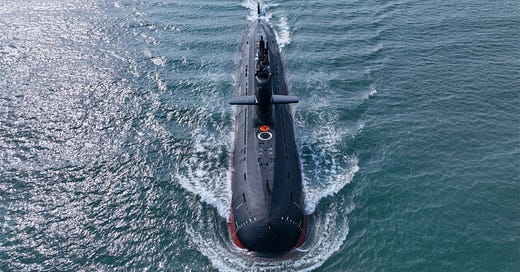Briefing: China's Military Modernization Efforts
China's military has been growing rapidly under Xi Jinping
Overview
China started a major military modernization effort after the First Gulf War to develop the People's Liberation Army into a global military power by 2049. The initiative for military modernization emerged from insights gained by studying U.S. military effectiveness during the Gulf War and other conflicts and China's shifting geopolitical objectives. The modernization of the PLA has incorporated substantial improvements to its doctrine and technological capabilities while updating equipment and organizational structures throughout its Army, Navy, Air Force, Rocket Force, and Information Support Force branches. Since President Xi Jinping took power China has stepped up its military advancements to confront threats from the U.S. and neighboring countries while expanding its global influence.
China has demonstrated extraordinary progress through advancements in naval power, missile technology, artificial intelligence (AI), and space capabilities. China's People's Liberation Army operates the largest naval force globally alongside fast-paced upgrades to its air force capabilities and rocket force. China's military progress notwithstanding, it continues to encounter obstacles when trying to match U.S. military prowess in specific areas including global power projection and joint operational readiness. China's military modernization is projected to maintain rapid progression as they establish key milestones for 2027, 2035, and 2049 to incorporate advanced technologies and attain complete dominance across all warfare domains.
Reasons for Modernization
China's modernization efforts stem from several key motivations:
Lessons from U.S. Military Dominance: Observing U.S. precision warfare during the Gulf War highlighted the importance of advanced technologies and joint operations.
Geopolitical Ambitions: The PLA's modernization supports China's goal of achieving "national rejuvenation" by asserting its sovereignty in disputed territories like Taiwan and the South China Sea while safeguarding overseas interests.
Perceived Threats: China's leadership views U.S. containment strategies as a direct challenge to its rise, necessitating a robust military capable of deterring intervention.
Progress Achieved
China has made significant strides across its military branches:
Army (PLAA): Modernized equipment includes lightweight tanks (Type 15), advanced artillery systems, and unmanned ground vehicles (UGVs). Training emphasizes combined arms operations.
Navy (PLAN): Now the largest navy globally with over 370 ships, including advanced aircraft carriers like Fujian and Type 055 destroyers equipped with hypersonic missiles.
Air Force (PLAAF): Rapidly modernizing with stealth fighters (J-20), strategic bombers (H-20), and advanced drones capable of integrated operations.
Rocket Force (PLARF): Expanded nuclear arsenal and developed hypersonic missiles like DF-17 capable of evading missile defenses.
Information Support Force (ISF): Established in 2024 to enhance cyber warfare, electronic warfare (EW), and AI-driven decision-making systems.
Advances Over the United States
China has achieved notable advantages in specific areas:
Naval Expansion: The PLAN's numerical superiority over the U.S. Navy enables greater regional dominance in the Indo-Pacific.
Hypersonic Weapons: China's DF-17 hypersonic missile system is considered a game-changer for counter-intervention strategies.
Artificial Intelligence: Integration of AI into combat systems positions China as a leader in intelligentized warfare.
Current Standing Compared to the United States
While China has made impressive gains, it still lags behind the United States in several critical areas:
Global Power Projection: The U.S. maintains unmatched capabilities for global deployment through its extensive network of overseas bases and alliances.
Joint Operations: Despite doctrinal improvements, China's joint operational capabilities remain less mature compared to U.S. forces.
Technological Edge: The U.S. retains advantages in areas like stealth technology and advanced command-and-control systems.
Future Outlook
China's military modernization is set to accelerate further:
2027 Milestone: Achieve integrated development of mechanization, informatization, and intelligentization.
2035 Goal: Complete comprehensive modernization of national defense capabilities in line with China's broader development goals.
2049 Vision: Transform the PLA into a world-class military capable of competing with or surpassing U.S. forces globally.
Conclusion
The modernization of China's military stands as one of the most major changes in international security since the Cold War ended. Beijing's strategic goals and historical military experiences have led it to make substantial investments in developing a cutting-edge military force that can contest U.S. supremacy throughout Asia and other regions. China demonstrates its resolve to restructure the international system through its advancements in naval capabilities and hypersonic weaponry alongside AI integration and space technology despite existing shortcomings in global military projection and joint operational readiness.
China's long-term objectives stand to become achievable through its ongoing dedication to innovation and infrastructure improvement. The path China takes with its aggressive influence projection creates potential threats to both regional stability and global security. Worldwide policymakers need to comprehend China's modernization initiatives to successfully navigate an evolving multipolar global order.
Further Reading
Why Is China Strengthening Its Military? It's Not All About War
MEETING CHINA’S EMERGING CAPABILITIES COUNTERING ADVANCES IN C YBER, SPACE, AND AUTONOMOUS SYSTEMS
Corruption May Postpone CCP’s Military Modernization, Report Says
China’s Military Modernization: Will the People’s Liberation Army complete its reforms?
Recent Trends: Revolution in Military Affairs in PLA post-gulf war?
Special Report: China proposes reforms to drive PLA modernisation




